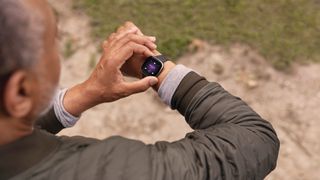Fitbit undertakes study to crack wrist-based BP tracking
Your smartwatch can be your diagnostic centre

Search the internet, you'll find a number of different wearables and fitness trackers that claim to track your blood pressure. However, many of these are estimations and aren’t certified medical devices. But things could soon change.
Wearable brand Fitbit is studying whether it can measure blood pressure through a new research for Sense smartwatch users.
To be specific, the study will look at how Fitbit devices can potentially measure something called Pulse Arrival Time (PAT), "which is the time it takes for a pulse of blood to reach your wrist after your heart beats, and explore the potential link to tracking blood pressure."
Fitbit Sense comes with electrodermal activity (EDA) to measure daily stress and comes with a heart rate tracker, electrocardiogram (ECG) monitor and skin temperature sensors.
- Your smartwatch could detect Covid-19 before you do
- Garmin vs Fitbit: How to pick the right fitness tracker for you
Fitbit probing health metrics available at users' wrist
Fitbit said previous research had found a correlation between PAT and blood pressure, but the correlation was not strong enough to predict blood pressure. These investigations were limited to either small data sets or specific environments like an intensive care unit. Fitbit Labs also had found a correlation between PAT and blood pressure in a small, 3-week internal study.
"The new study will extend this work to a broader population in order to learn more about how PAT measurements change under a variety of conditions," the company said."
"It’s a hard scientific challenge, and a lot of work remains to be done to understand the best way to do this, but we have a history of advancing technology to make previously inaccessible health metrics available to Fitbit users from their wrist, so it’s a challenge we’re very passionate about solving," said Shelten Yuen, Principal Scientist at Fitbit, who is leading the study.
Get daily insight, inspiration and deals in your inbox
Get the hottest deals available in your inbox plus news, reviews, opinion, analysis and more from the TechRadar team.
Fitbit Sense users in the US who are at least 20-years-old, will receive a notification on their app if they are eligible to participate in the month-long study.
If successful, the company sees having easy access to blood pressure readings as being potentially helpful for those with hypertension.
Wearables and the future of blood pressure reading
Actually, it is not as if cuff-based blood pressure reading wearable is not available in the market. Omron HeartGuide is there. But its cost is prohibitive, as it is made by a health tech company, and not a lifestyle wearable company.
There have also been rumours that Apple might soon introduce cuff--based blood pressure reader. Apple registered a patent last year that described how to measure blood pressure using pressure sensors in the wristband of a wearable.
Further, Samsung Health Monitor app allows you to use the PPG (Photoplethysmography) sensor method already in the Samsung Galaxy Watch 3 or Galaxy Watch Active to take a blood pressure reading. PPG is usually used to track heart rate. But it can also take optical readings of your arteries to estimate blood pressure.
But this is a spot check, which means you decide when you want to take one – it doesn’t happen automatically like tracking your heart rate. It also needs to be checked against a cuff reading every so often.
As you can see, checking blood pressure isn’t always easy, especially if people don’t have a blood pressure cuff at home.
But as research intensifies, it is only a matter of time before wearables become the norm to check blood pressure in a non-cumbersome way.

Over three decades as a journalist covering current affairs, politics, sports and now technology. Former Editor of News Today, writer of humour columns across publications and a hardcore cricket and cinema enthusiast. He writes about technology trends and suggest movies and shows to watch on OTT platforms.
